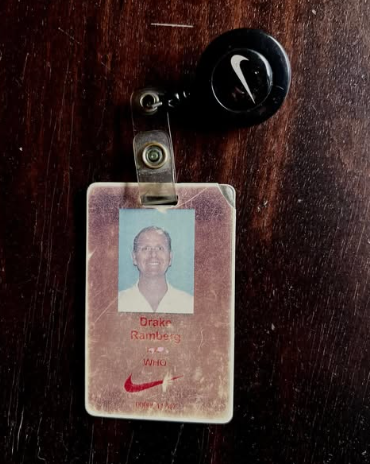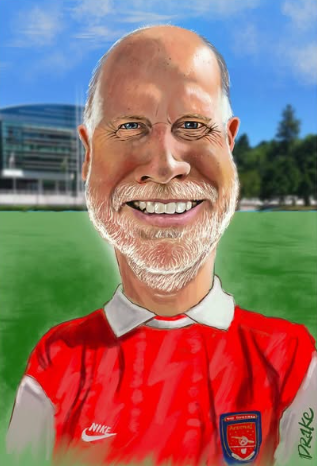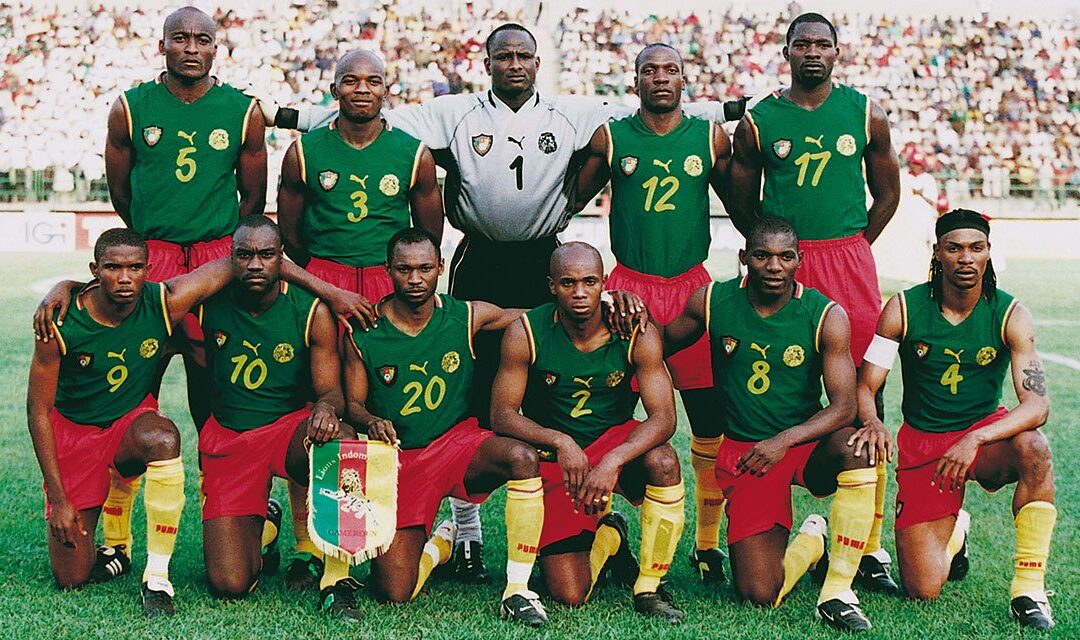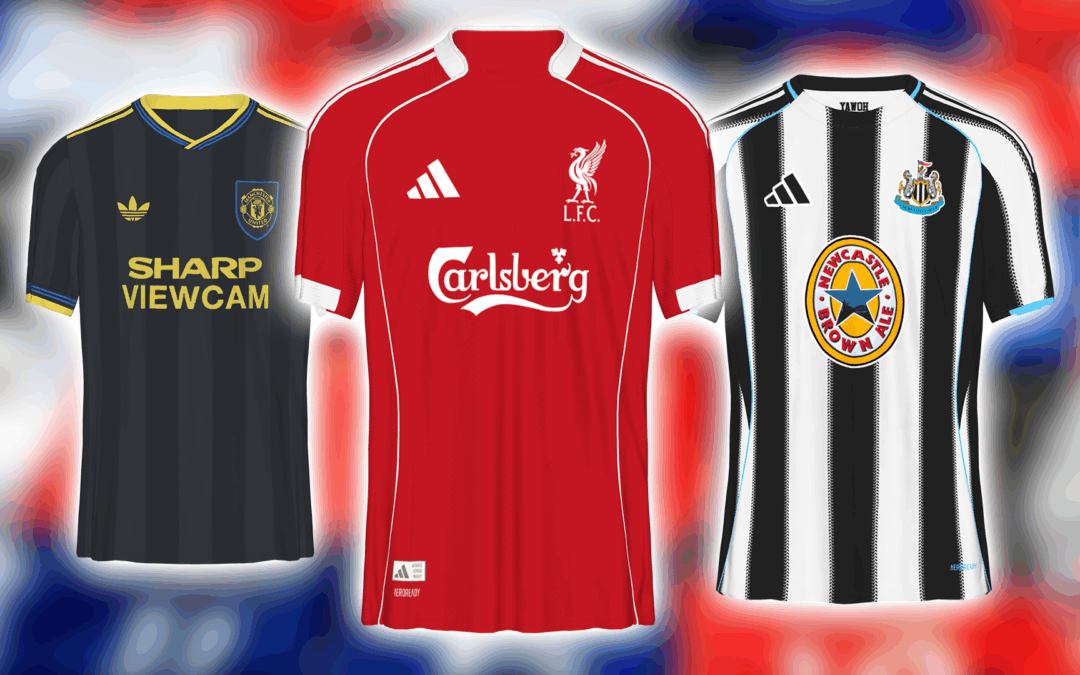Everyone knows the iconic Arsenal lightning bolt that appeared on the 1994/95 season kits, but not many people realise where it came from.
The pattern has become a club icon, transcending what Drake Ramberg might have originally expected when he thought of the design.
“To have people actually care and know that history now, I mean, who would have thought 30 years later that there would be such a following around that era.”
Through the laptop screen, Drake is sitting in his home in Oregon, in front of a full rail of football shirts and various framed drawings of different sports legends’, so it’s easy to see the kind of person he is.
“I mean, my dad was a teacher, my mom worked at a school. We always had art supplies around and there’s a lot of rainy winters, like England. When we were younger – me and my younger brother and sister – it seemed like we were always drawing.”
Drake Ramberg pursued a fine art degree at the University of Portland, eventually working as a freelancer at Nike in 1986.
“Initially, I got rejected by the HR team, but eventually my resume and my information made it over to Angela Snow, who was heading up the art department in the Nike apparel division then, and she brought me in.”
With the offices on his doorstep, it was always going to be Nike.
“But this is probably a good point to explain that I’m just one of a group, a team of people. So myself, as a graphic designer, I’m joined at the hip with the apparel designer, and they’re responsible for figuring out the collars, the type of sleeves, the cuffs, the fabrics, and the fit and shape, and then I’m responsible for all the graphics on the style,” Drake explains as I begin to ask him about the process of designing shirts.

However, one thing I hadn’t necessarily considered before interviewing him was the learning curve he’d have to undertake as an American working closely with European clubs.
“When I arrived over in Europe as an American, I had to learn a lot about Borussia Dortmund and Arsenal and what makes them different from Tottenham or Manchester City. And also with home kits and the away kits, don’t do their rivals colour, don’t do this, don’t do that.”
Drake had a lot of learning to do, but he took on the challenge, learning everything he could about the clubs, the fans and the differing cultures.
“The fans could easily smell out something if it just didn’t feel like it was right, so that’s where the research went in, showing that you really understood their culture and their legacy of the sport.”
Once you had fully researched the club, only then could you even consider beginning a design, and at the start of his career, Drake Ramberg did this all manually.
“As I started designing, the computer wasn’t even used the way it is today, of course. And so the benefit was, you did a lot more stuff by hand. You were hand drawing, we had a dark room, and we were doing a lot of stuff with a camera or copy machines, and there’s some beauty to that.”
But there were still benefits to the improvement in technology whilst Drake was at Nike.
“Once we started going digital, it really transformed the whole business. The beauty of working on a computer is you can save files, you can undo mistakes, so it’s a lot more efficient.”
And especially considering the fact that Drake was based in Germany and Amsterdam but working with Nike headquarters in Oregon, technology made communication a whole lot smoother.
“I was faxing my leadership in the States for input, feedback, and direction, giving them updates continually. Then if I had to show them art and design work, I had to make a copy of it and embed it in the fax. Then we’d fax it off and wait until they’d wake up the next morning and respond. There was this constant way of communicating that was really transformed in a huge way once we got email, and it really made this global approach to creating products so much smoother.”
Still, there is something to be said about the old-school way of designing, and Drake encourages that.
“I always talk to designers today and just encourage them to go by hand. It’s great to start with sketching and using collage and painting and taking a handmade approach before you just jump straight onto a computer.”

Once the team had agreed on designs, the next step is to pitch them to the club they’re working for, often pitching directly to the presidents, managers and owners of a club.
“Sometimes there were commercial directors or equipment people or the kit guys who a lot of times might have input on long sleeves or short sleeves, or goalkeeper kits and stuff like that.”
Drake laughs as he remembers one time during a pitch when there were a lot more people than he was expecting.
“I remember going to Paris and pitching to PSG, and it seemed like there were like 25 people speaking French! And then you’d have other pitches where it was only three or four people. Each club has their own culture, personality and hierarchy.”
Bringing ideas to the table, the pitching team are very specific with the way they present new designs.
“It wasn’t a buffet table like, oh, here’s 20 different options, you know? We guide them towards it; we’re the experts in kit design, here’s what we think is what you need, here’s what’s really going to represent the legacy of your club. And if we did it right – which we usually did – it was clear that we were on the right path. Sometimes there’d be some pushback, and of course, you’ve got to go back to the drawing board because we didn’t quite nail it, but that was our way of putting our best foot forward.”
And so, in 1994, Drake began designing with Arsenal.
“I was trying to reveal some cool element that nobody has revealed before, right? So obviously you start thinking, okay, well, you’ve got the cannon, you’ve got the word ‘Arsenal’, you’ve got the word ‘Gunners’. So how can you take all these elements and then create a story? You’re basically using the Jersey as a way to be a storyteller.”
Drake made some decisions any Arsenal fan will recognise as being iconic in the best ways.
“On the crest of the patch, I thought it’d be cool to have ‘The Gunners’ across the top which was different. And then we wanted to be kind of cheeky, so we put Arsenal down on the tail which hadn’t been seen before. I remember when we pitched that to the club, we were like, ‘Yeah, and when a player wears the shirt untucked, then they’ve got Arsenal on the arse!’ They thought that was pretty funny to have Americans trying to be clever, but they loved it.”

But it wasn’t all fun and games. Drake knew he had to make something that fans could identify with, and unknowingly created one of the most iconic graphics to date.
“How do you kind of come up with something that speaks to the idea of a Gunner without just a bunch of cannons? And so, I landed on the idea of a lightning bolt. It represents speed and power and it’s kind of symbolic of an arsenal of ammunition.”
That 94/95 season kit is iconic, but the away shirt changed the next season.
“The next season, it was like, let’s make it kind of like a half-half shirt for the away with dark blue and a teal blue, and have the lightning bolt break up the shirt that way. Because, you know, there are shirts out there, like Blackburn Rovers, that always kind of had a half-half look, and so it felt true to the sport. Arsenal had never really done a half-half, but to do it in a bold, iconic way with lightning bolts was…God, it was just a cool way to do it. And the club loved it!”
And the lightning bolt stuck. It’s a graphic that has returned in kits since, like the 22/23 and 23/24 home kits, as well as the leaked 25/26 away kit.
“It’s heartwarming to see that even though Arsenal’s no longer with Nike that the club and the brands that are doing the kits now see the importance of it as a key element of their past, and have brought it forward to the recent kits. It feels great.”
Drake has also noticed the more recent attitude towards vintage kits becoming streetwear and can see a whole new side of the kits now.
“You have the task at hand when you are designing the kit for it to be representative of what the club stands for at that point in time and what they needed, staying faithful to their culture, their brand and their identity and all that. But you wanted it not to be a novelty. It should last throughout time. But who knew that they’d become fashionable! To have retro football shirts 20, 30, years later all across Instagram and social media, in street fashion, I mean, it just all comes together. Who would have thought 30 years later that there would be such a following around that era?”
So, as my time talking to Drake Ramberg came to an end I had a few more burning questions for him that I knew any fan of the kits he had designed would want to know:
What shirts did you have the most fun designing?
“I’d say my top one or two would be the Dortmund wings shirt, just because it was such an iconic look that represented their club in a new way, and then they won their first Bundesliga title wearing it. Then I’d say the ’95 away Arsenal kit, just because, again, it was such a unique look and beloved by fans to this day.”
If you could go back in time and tell yourself one thing or give yourself one piece of advice, what would it be?
“Oh, boy. I mean, I kind of feel like I did what I needed to do and wanted to do, and enjoyed the ride the entire time. So I don’t have any regrets. I guess you never know what the future is going to have in store. I would just say take it in enjoy it, and that’s what I tried to do. I can’t think of any moves or things that I would have done or should have done differently or better. I think it was just the right thing at the right time. And people around me at Nike gave me the opportunities and saw something in me and trusted me to do the job that I did.”
If you could only wear one shirt for the rest of your life, what would it be?
“Well, it’s the Arsenal 1994 home red shirt, of course. Gunner till I die, right?”
Drake Ramberg on Instagram
Drake Ramberg on LinkedIn



